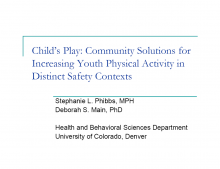We are pleased to announce an exciting new alliance between Active Living Research and GP RED to co-host and coordinate...
Child's Play: Community Solutions for Increasing Youth Physical Activity in Distinct Safety Contexts

Presentation at the 2010 Active Living Research Annual Conference
Background:
Neighborhood safety may influence physical activity, yet we know relatively little about how people conceptualize safety in their neighborhoods and what interventions are needed to increase physical activity among youth in different neighborhood safety environments.
Objectives:
Objective 1: Identify homogenous block group clusters by known physical and social correlates/measures of safety, including: fear of crime, traffic safety, social cohesion, discrimination and incivilities.
Objective 2: Within a community-based participatory research context, use concept mapping methodologies to examine how solutions for increasing pediatric physical activity vary within and between different safety contexts.
Methods:
To identify different neighborhood safety contexts we conducted a cluster analysis of aggregated (census block group level) responses to 950 household surveys and walking audits of representative blocks in the five included neighborhoods. Five aggregated scales were included in the cluster analysis: fear of crime, traffic safety, social cohesion, discrimination and incivilities. Concept mapping attendees will be sampled from the identified clusters.
Using a community-based participatory research process, an adult and youth community advisory group met monthly to guide the research. Members of the advisory group ranged from 8 to 84 years of age, and meetings were conducted in English and Spanish. The group named itself, established its own group agreements, refined the research questions, and helped design data collection methods for concept mapping sessions. Advisory group members are also being trained to facilitate and record the concept mapping sessions.
Results:
A five cluster solution was selected to identify distinct safety environments (see graph). One-way ANOVA analysis comparing block groups in the five clusters rejected the null hypothesis of no difference between the clusters for each of the cluster analysis scales.
The concept mapping focus prompt that will be used is, “What specific actions could be taken to improve your neighborhood for youth aged 10-14, especially actions that would encourage youth to be more active outside?” Ratings favored by the advisory group include necessity, i.e., “How necessary do you think the change is?” and feasibility, i.e., “How possible do you think it is to make this change compared to other changes” Advisory board members have undergone two facilitation trainings and Institution Review Board certification, and recruitment efforts are ready to commence.
Conclusions:
This community-based participatory research has engaged a diverse group of participants in concept mapping planning, resulting in greater value and relevance of this research and increased skills of community members and the researcher alike. Concept mapping will commence in September, including 150 people who will represent the different safety environments identified in the cluster analysis. We will learn whether people from different environments rate solutions for increasing physical activity among youth as similarly necessary and feasible.
Support:
Support for this research is provided by a grant from the Robert Wood Johnson Foundation, Active Living Research program.
Related Tools & Resources
STAY UP TO DATE
RECENTLY ADDED TOOLS & RESOURCES
MOVE! A BLOG ABOUT ACTIVE LIVING
The "Active Living Conference" aims to break down research and practice silos and...







